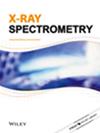Scanning macro x‐ray fluorescence spectroscopy maps for matching 17th century paintings color areas to different earth pigments uses and for investigating attribution issues
IF 1.5
4区 物理与天体物理
Q3 SPECTROSCOPY
引用次数: 0
Abstract
Fe and/or Mn‐containing yellow ochre, red ochre, and umber earth pigments are omnipresent in 17th century paintings. Less common in the materials used in historical paintings of this period is the Fe and Mn‐rich earth pigment sienna. Different uses of historical pigments in one painting by Georg Flegel (1566–1638) and another version of the same painting but of disputed attribution were recently uncovered by means of macro‐x‐ray fluorescence (MA‐XRF) scanning and other non‐invasive analytical techniques. In this paper, an approach solely based upon the correlation of Fe and Mn MA‐XRF maps with the optical image of the painting is compared to the use of Mn/Fe correlation plots. The identification of clusters within a plot of the Fe counts vs. the Mn counts can aid to infer whether an area with a certain color matches with the use of the earth pigments found in the two paintings and to ultimately shed light on the different usage of these pigments. The analytical thresholds found in the Mn/Fe correlation plots allowed to identify clusters differing in composition, which matched an area of a certain color with the earth pigments used therein. This highlighted the differences and similarities between the two paintings, ultimately ascertaining the lower value of the painting of disputed attribution. The analysis of single‐pixel spectra allowed refining the interpretation of specific Mn/Fe correlation plots. The purpose of these data evaluation steps is presented and the limitations of the proposed methodology are also discussed.扫描宏观x射线荧光光谱图,将17世纪绘画的颜色区域与不同的土颜料用途相匹配,并用于调查归属问题
含铁和/或锰的黄赭石、红赭石和褐土颜料在17世纪的绘画中随处可见。在这一时期的历史绘画中使用的材料中,不太常见的是富含铁和锰的土颜料锡耶纳。最近,通过宏观x射线荧光(MA‐XRF)扫描和其他非侵入性分析技术,发现了Georg Flegel(1566–1638)的一幅画和同一幅画的另一个版本中历史颜料的不同用途,但其归属存在争议。在本文中,将仅基于Fe和Mn MA‐XRF图与画作光学图像的相关性的方法与使用Mn/Fe相关性图进行了比较。在Fe计数与Mn计数的图中识别簇可以帮助推断具有特定颜色的区域是否与两幅画中发现的地球颜料的使用相匹配,并最终揭示这些颜料的不同使用。在Mn/Fe相关性图中发现的分析阈值允许识别成分不同的团簇,这些团簇与其中使用的地球颜料匹配特定颜色的区域。这突出了两幅画之间的异同,最终确定了这幅有争议归属的画作的较低价值。单像素光谱的分析使特定Mn/Fe相关图的解释更加精细。介绍了这些数据评估步骤的目的,并讨论了所提出方法的局限性。
本文章由计算机程序翻译,如有差异,请以英文原文为准。
求助全文
约1分钟内获得全文
求助全文
来源期刊

X-Ray Spectrometry
物理-光谱学
CiteScore
3.10
自引率
8.30%
发文量
38
审稿时长
6-12 weeks
期刊介绍:
X-Ray Spectrometry is devoted to the rapid publication of papers dealing with the theory and application of x-ray spectrometry using electron, x-ray photon, proton, γ and γ-x sources.
Covering advances in techniques, methods and equipment, this established journal provides the ideal platform for the discussion of more sophisticated X-ray analytical methods.
Both wavelength and energy dispersion systems are covered together with a range of data handling methods, from the most simple to very sophisticated software programs. Papers dealing with the application of x-ray spectrometric methods for structural analysis are also featured as well as applications papers covering a wide range of areas such as environmental analysis and monitoring, art and archaelogical studies, mineralogy, forensics, geology, surface science and materials analysis, biomedical and pharmaceutical applications.
 求助内容:
求助内容: 应助结果提醒方式:
应助结果提醒方式:


